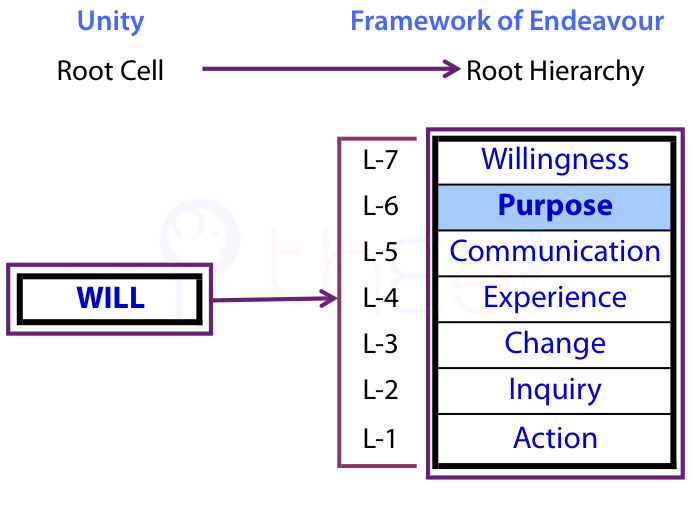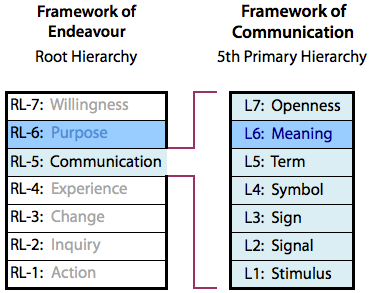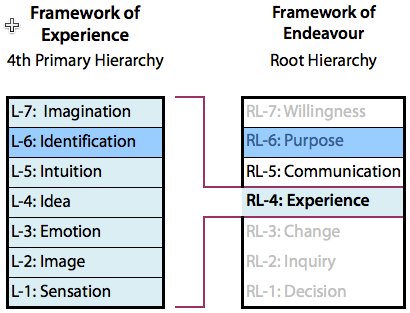The Architecture uses Processes
THEE-Path
The architectural location of a taxonomic entity is metaphorically viewed as a place on a path generated by processes.
Here, you must distinguish abstract architectural processes from practical psychosocial processes. THEE represents human activity and its elements are named using terms that are familiar and immediately understood. However, terminology for discussing the organization of THEE entities is required. These essential architectural concepts are unavoidably jargon-like.
Get rapid clarification of terminology by using the Terms tab
located at the top of the left-hand navigation column.
When I say that a THEE entity emerges or manifests on a «THEE-Path», I mean that all entities and taxonomic forms can be traced back to one cell-entity that is referred to variously as: Origin, Root, Root cell, or by its formal name: «».
In the initial 10-15 years of inquiry, discovery and formulation was arduous, tortuous and fragmentary. There was no overall architecture and therefore much uncertainty about abstract processes. Now that there is some clarity, the path can assist inquiry. Processes indicate what happens on the path and their properties contribute to discovery and validation of new conjectures about entities.
Examples of THEE-Paths:
- to reach Politics frameworks
 ;
; - to reach Prosperity frameworks
 .
.
Taxonomic Processes
The following are explained below (click to be taken directly):
- emanation
- condensation
- relation (syn. interaction; influence)
- nesting
- Q-expansion
- grouping
-
&
- others: generation, transition, encompassing, implication, selection, resonance.
To appreciate the examples and explanations, some familiarity with the basic THEE forms is required.
Emanation
... is the process by which a hierarchy emerges from a certain cell, is perceivable within that cell, or replaces that cell by specifying in a differentiated and specific fashion every category that could be contained within the original cell. Nothing can exist within the emanating entity that is not within the emanated entity (and vice versa).
In other words, everything in the new structure is a more detailed expression of the nature of the original cell-level.
e.g. The Root Cell becomes the Root Hierarchy:

and then each of the 7 Levels in the Root Hierarchy emanates a Primary Hierarchy:
e.g. becomes

The emanated structure represents a differentiation of the original entity.
Condensation
... is the process that is the reverse of emanation.
The simple unified entity is a condensation of the original complex structure. This is useful when there is no need to discriminate varieties.
e.g. condense to at times when the particular sort of inner feeling is irrelevant to the analysis or application because the focus is on, say, a broader relation between , and .

Relation (syn. Interaction, Influence)

... is a process whereby a particular entity affects another entity.
Relations may be either direct or indirect (i.e. requiring mediation).
The diagram at right (from ) shows a direct influence by on but only an indirect influence on the significance of in society. As here, there is usually a variety of paths of indirect influence.
Entities close in formulae tend to affect or influence each other more than entities in different, distant parts of the Taxonomy. In everyday life, the mind-self seems to move easily about THEE and distance (= dissimilarity) may not be a factor.
Nesting
| 1st Principal Typology
Secondary Hierarchy |
||||||
| L'-7 | ||||||
| L'-6 | ||||||
| L'-5 | ||||||
| L'-4 | ||||||
| L'-3 | ||||||
| L'-2 | ||||||
| L'-1 | ||||||
| 1st Primary Hierarchy | ||||||
| L-7 | ||||||
| L-6 | ||||||
| L-5 | ||||||
| L-4 | ||||||
| L-3 | ||||||
| L-2 | ||||||
| L-1 | ||||||
... is the process characteristic of the 6th Level of various THEE hierarchies whereby it generates a further 7-level hierarchy, with each Level being a Type that guides the use of all the hierarchical Levels.
The Typology is definitely not emanated (see above) in the case of Principal Typologies that are found within Primary Hierarchies, because the 6th Level can also manifest in many other ways, apart from its expression as Types within the relevant Typology.
Note that Tertiary Typologies within L'6 of Principal Typologies appear to be generated by emanation rather than nesting. This applies to . Further inquiry is required to confirm the conjecture applies generally.
The example at right shows the 1st Primary Hierarchy with its nested Principal Typology: the . It is thought that the Types get their nature from corresponding Levels in the Primary Hierarchy (Level names not shown because currently only provisionally identified). Use of a is just one sort of : there is an infinity of others in everyday life.
For another example: see the Root Typology.
Q-Expansion
... is the process whereby a Modal Hierarchy consisting of 4 operating Styles is applied to each of the 7 Types in a Principal Typology to generate a 28-level structure of Subsidiary Types. See diagram below.

Example: The 7 Types can be expanded to 28 Levels for by applying 4 Styles to each. These then reflect 28 distinct capabilities to perceive complexity, make sense of the environment and so carry responsibility for work of different sorts. See more![]() .
.
The complexity of this process and its implications requires its own Topic.
Grouping
... is the process whereby adjacent Level-entities are combined or viewed together to form a new psychosocial entity.
Production of Q-structures (hierarchies, Spirals, Typologies) is based on grouping the 4 Styles of one Type and the lower 3 Styles of the next higher Type. (At Type #7, the next higher Type is #1.)
Structural hierarchies are formed from holistic 7-level hierarchies by combining adjacent Levels systematically in all possible ways.
Hierarchies can be split in two in every possible way leading to two groups: as currently being explored in the Architecture Room![]() . This also shows up in Trees which are commonly divided in two ways:
. This also shows up in Trees which are commonly divided in two ways:
- grouping the upper 2 Levels as «potentials», and grouping the lower 5 as «actuals».
- grouping the upper 3 as «context», and grouping the lower 4 as «content».
Transformation
... is the process whereby the function and formula of a cell-entity alters to become a different cell, referring to a distinctly different but closely related entity.
There are at least four types of transformation:
Emanating Transform
... is the process of emanation described above.
Contextualizing Transform
... is the process whereby a Type in a Typology becomes a Mode in a Spiral.![]() More...
More...
Dynamizing Transform
... is the process whereby a dynamic duality converts each Level in a holistic hierarchy into either one or two Centres of influence within that level. Dynamic processes are found between Centres whose total pattern forms a Tree.
Combining Transform
... is the process whereby a Grouping of adjacent Levels leads to a new discrete Level in a Structural Hierarchy. The quality of the original Level being grouped is affected by its position in the Group
Additional Process Terms
● Generation
... is a general term used for conversion processes. e.g. Levels converted to Centres are said to «generate» those Centres, Q-expansion generates Q-hierarchies.
● Transition
... is the move across boundaries that define discontinuous psychosocial states within Frameworks, e.g. moving up or down a hierarchy, moving from one Mode in a Spiral to the next. Transitions within THEE may be momentous in the social realm and hence stressful or highly significant for the person or social body affected.
● Encompassing
... is a subsuming relation within a hierarchy in which a higher Level inherently includes or assumes all Levels below it. This occurs in all holistic hierarchies, but not in Typology Hierarchies.
● Implication
... is a predictive relation within a hierarchy whereby a particular Level implies or requires the existence of additional Levels either above or below.This occurs in all holistic hierarchies, but not in Typology Hierarchies.
● Selection
... is the process of focusing on one particular entity (Level, Centre, Channel &c.) for some formal purpose. This occurs when comparing distant elements.
... is the process by which entities with similar formulae create an inner sense of their similarity. The feeling may be so intense that it leads people to falsely assert identity of the entities. Confusion results in practice if distinct but resonating entities are given identical names. See examples of name confusion.
Originally posted: August 2009; Last updated 2-Feb-2014.
All posted material is part of a scientific project and should be regarded as provisional. Visitors are encouraged to think through the topics and propositions for themselves. Copyright © Warren Kinston 2009-2016.
All Rights Reserved.